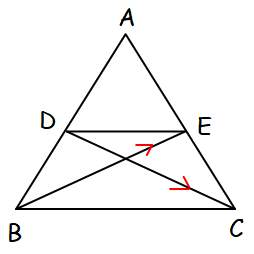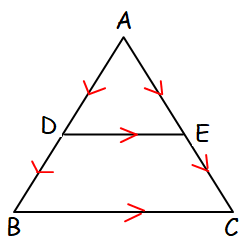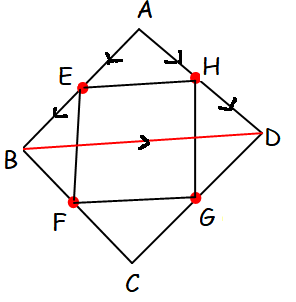THEORY PROBLEMS AND SOLUTIONS IN VECTOR
Question 1 :
If D and E are the midpoints of the sides AB and AC of a triangle ABC, prove that BE vector + DC vector = (3/2) BC vector.
Solution :

OA vector = a vector,
OB vector = b vector,
OC vector = c vector
Since D is the midpoint of the side AB,
OD vector = (a vector + b vector)/2
Since E is the midpoint of the side AC,
OE vector = (a vector + c vector)/2
BE vector = OE vector - OB vector
= [(a vector + c vector)/2] - b vector
= (a vector + c vector - 2b vector)/2 ----(1)
DC vector = OC vector - OD vector
= c vector - [(a vector + b vector)/2]
= (2c vector - a vector - b vector)/2 -----(2)
(1) + (2)
= (a vector+c vector-2b vector)+(2c vector-a vector-b vector) / 2
= (-3b vector + 3c vector) / 2
= (3/2) (c vector - b vector)
= (3/2) (OC vector - OB vector)
= (3/2) BC vector
Hence it is proved.
Question 2 :
Prove that the line segment joining the midpoints of two sides of a triangle is parallel to the third side whose length is half of the length of the third side.
Solution :

In triangle ADE,
AD vector + DE vector = AE vector
DE vector = AE vector - AD vector ---(1)
E is the midpoint of the side AC
So, AE = EC
AE = (1/2) AC vector
D is the midpoint of the side AB
So, AD = DC
AD = (1/2) AB vector
By applying the value of AE and AD, we get
DE vector = [(1/2) AC vector] - [(1/2) AB vector]
DE vector = (1/2) [AC vector - AB vector] ---(2)
In triangle ABC,
AB vector + BC vector = AC vector
BC vector = AC vector - AB vector
By applying the value of BC vector in (2), we get
DE vector = (1/2) BC vector
Hence the sides DE and BC are parallel.
Question 3 :
Prove that the line segments joining the midpoints of the adjacent sides of a quadrilateral form a parallelogram.
Solution :

Given : ABCD is a quadrilateral
E, F, G and H are midpoints of the sides AB, BD, DC and CA respectively.
In triangle ABC :
AB vector + BD vector = AC vector ---(1)
In triangle AEH :
AE vector + EH vector = AH vector
EH vector = AH vector - AE vector
Instead of AH vector, we may write (1/2) AC vector. Instead of AE vector, we may write (1/2) AB vector.
EH vector = (1/2) AC vector - (1/2) AB vector
= (1/2) [AC vector - AB vector]
From (1), we get
BD vector = AC vector - AB vector
EH vector = (1/2) BD vector ----(A)
Hence we conclude that the sides BD and EH are parallel.
Now, let us consider the triangle BCD and triangle FCG
BC vector + BD vector = CD vector ---(2)
In triangle FCG
FC vector + FG vector = CG vector
FG vector = CG vector - FC vector
= (1/2)CD vector - (1/2)BC vector
= (1/2) [CD vector - BC vector]
From (2),
CD vector - BC vector = BD vector
= (1/2) BD vector-----(B)
From (A) and (B), EFGH is a parallelogram.
Kindly mail your feedback to v4formath@gmail.com
We always appreciate your feedback.
©All rights reserved. onlinemath4all.com
Recent Articles
-
Digital SAT Math Problems and Solutions (Part - 150)
Apr 25, 25 11:46 AM
Digital SAT Math Problems and Solutions (Part - 150) -
AP Calculus AB Problems with Solutions (Part - 19)
Apr 24, 25 11:10 PM
AP Calculus AB Problems with Solutions (Part - 19) -
AP Calculus AB Problems with Solutions (Part - 18)
Apr 24, 25 11:06 PM
AP Calculus AB Problems with Solutions (Part - 18)
